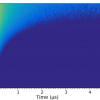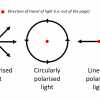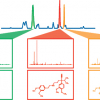Spectroscopy Applications
Characterisation of the absorbance, emission and lifetime of novel quantum dot emitters helps establish structure–property relationships.
For certain molecules and samples, “normal” Raman spectroscopic data can be enhanced by controlling the polarisation of light exciting the sample, and of light scattering from it. Analysis of Raman spectra gathered using this technique can provide information about the molecular structure of a sample, including the symmetry of its vibrational modes, as well as information about highly-ordered samples, such as crystals, polymers, and carbon materials.
MetID typically requires analysis of mass spectrometry (MS) data to identify metabolic “hot spots” and elucidate biotransformation pathways. This remains the primary challenge despite significant instrumental and software advances. MetaSense™ overcomes these challenges and allows users to save time and improve collaborations.
This work builds on our previous study of arsenic species in apple juice by incorporating several improvements to the methodology and exploring the analysis more deeply.
In this article, three real-life Raman quantitative and semi-quantitative analysis applications are discussed. These applications showcase the versatility of Raman spectroscopy and the potential impact that it can make in various industries.
The inability to have children can cause great heartache for many couples, with infertility affecting at least one-in-six couples in Britain and one-in-eight in the United States. The most common cause is male infertility, usually characterised by sperm with little or no mobility. One treatment commonly used in these cases is in vitro fertilisation (IVF). This involves injecting sperm into the egg in a laboratory.
The NIR (900–2500 nm) region was largely neglected by analysts for many years because of the complex nature of the spectra produced by water, proteins etc. in this region. However, thanks to the many and varied multivariate mathematical calibration approaches now available, broadly described by the term “chemometrics”, it has recently found new and important applications, particularly in the pharmaceutical and food industries for raw material and Quality Assurance procedures.
The determination of inorganic elements in food substances is critical for assessing nutritional composition and identifying food contamination sources. The measurement of inorganic elements is challenging because there is a wide variety of edible substances. As a result, highly diverse matrices must be analysed accurately. The different matrices can lead to numerous interferences on inorganic elements of interest and the interferences can vary with matrix composition.
There are three main classes of triglycerides—saturated fats, and unsaturated trans-fats and cis-fats. Unsaturation indicates the triglyceride contains one or more carbon–carbon double bonds. Most natural oils like vegetable oil consist of cis-fats and are poly-unsaturated, meaning they contain more than one double bond. The cis nature prevents solidification of the fat; trans-fats solidify more readily, which can lead to blockages in the bloodstream. Fourier transform infrared (FT-IR) spectroscopy functions well to analyse trans-fats.




